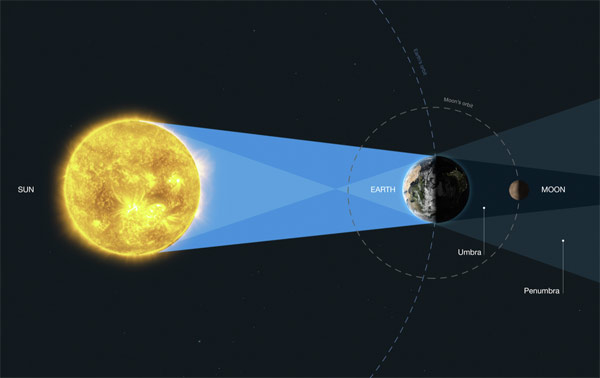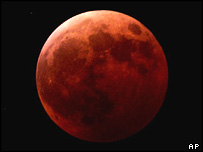lunar eclipse

Diagram of lunar eclipse. When the Moon is entirely in Earth's umbra (known as a total lunar eclipse or umbral eclipse), all sunlight reaching the lunar surface has been refracted or scattered through Earth's atmosphere. When the Moon is in Earth's penumbra (known as a penumbral eclipse), illumination comes from both direct sunlight and sunlight refracted and scattered through the planet's atmosphere. Credit: M. Kornmesser (ESA/Hubble).

Copper-colored Moon during eclipse.
A lunar eclipse is the passage of the Moon through Earth's shadow. The eclipse may be total (the Moon passing completely through Earth's umbra), partial (the Moon passing partially through Earth's umbra at maximum eclipse), or penumbral (the Moon passing only through Earth's penumbra). Total lunar eclipses tend to be brighter when the atmosphere is relatively clear of volcanic and other dust: a dirty atmosphere blocks more sunlight and dims the eclipse.
Unlike a total solar eclipse, which lasts a maximum of 7½ minutes, the lunar variety happens at a more leisurely pace. The shadow made by Earth as it blocks the Sun is 16,782 kilometers wide where the Moon crosses through it. The Moon itself is 3,476 kilometers wide, and is traveling about 3,700 kilometers per hour. So, roughly 3 hours elapse from the time the Moon first touches the umbra until the last part of the Moon passes out of it. The middle third of the journey is the part of the eclipse that is total. The magnitude of a lunar eclipse is the fraction of the lunar diameter obscured by Earth's shadow at the greatest phase of an eclipse, measured along the common diameter.
Although lunar eclipses have no great scientific significance, they are a wonderful natural spectacle. In the past things were different. A lunar eclipse was a portent from the sky, possibly a sign of divine displeasure. But as superstition gave way to reason, it came to be regarded as an example of the majestic clockwork of the heavens. Thomas Hardy said the movement of Earth's shadow over the Moon had an "imperturbable serenity". The color effect is the stuff of myth and legend. An account in 331 BC said: "...all her light was sullied and suffused with the hue of blood." Some ancients called it "the time of the blood of the Great Mother's wisdom", linking the Moon's color with menstruation. This was a natural thing to do given the link between the length of the month and human fertility. In 1503, Christopher Columbus, stranded in the Caribbean, used a lunar eclipse he knew would take place to impress the natives and secure respect and fear, as well as a regular supply of food.


